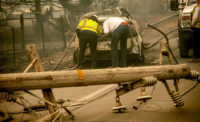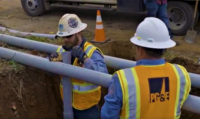High costs are threatening to reduce the scope of a plan to prevent wildfires by burying thousands of miles of power lines in high-risk areas in California. State regulators have proposed lower-cost solutions to reduce utility bill increases, but power company Pacific Gas & Electric says those alternatives would be less effective at reducing fire risk.
PG&E, an Oakland, Calif.-based utility that serves about 16 million people with electric and natural gas service over a 70,000-sq-mile area, announced plans two years ago to underground 10,000 miles of power lines as part of its wildfire safety efforts. Power lines have been blamed for starting about half of the state’s most destructive wildfires.
The California Dept. of Forestry and Fire Protection identified that contact between a tree and a PG&E line was the cause of the 2021 Dixie Fire, which burned more than 963,000 acres and destroyed 1,311 structures.
The company has so far undergrounded 384 miles of the 2,300 miles of power line it aims to bury through 2026, according to PG&E spokesperson Jennifer Robison. Undergrounding reduces weather-related damage to lines, improves their resilience and reduces need over time for other wildfire mitigation efforts such as trimming trees.
“Undergrounding essentially eliminates wildfire ignition risk from those lines and helps reduce long-term operations and maintenance costs,” Robison says.
But the work is costly. The California Public Utilities Commission estimates the price of undergrounding at $3.3 million per mile, although PG&E costs have averaged $3 million per mile this year, and the company anticipates costs dropping to $2.8 million per mile as the program scales up, she says. PG&E funds work through rates paid by its customers, and it has sought to raise those rates to pay for the project.
The commission has the final say over the rates utilities can charge customers, and is currently considering PG&E’s request to increase its revenue requirement to $15.4 billion to pay for the work. That would be a 26% increase from its authorized requirement last year. To lessen the increase, administrative law judges drafted a proposal that would instead increase the revenue requirement by 13%, and Commissioner John Reynolds offered an alternative proposal with an increase of just 9%.
To reduce the rate increase, both proposals would cut the length of undergrounded power lines and instead rely on installing covered conductor for the remaining segments. The administrative law judges recommended undergrounding 200 miles of line and using covered conductor on 1,800 miles, while Reynolds’ plan would underground 973 miles and use covered conductor on 1,027 miles.
Covered conductor features insulating layers to protect the wires from coming into contact with other objects to reduce the risk of starting a fire. Installation of covered conductor costs about $800,000 per mile, according to the commission.
“At this point in time, the aggressive installation of covered conductor on bare electrical lines is also the commission’s preferred strategy because it reduces the risk of ignitions by a projected percentage that is comparable to the more costly strategy of undergrounding electric distribution lines,” officials wrote in their proposal.
Robison says PG&E uses covered conductor “where it makes sense,” but it’s less than 65% effective by itself at reducing wildfire risk on a specific circuit. Public safety power shutoffs are needed to increase its effectiveness at preventing fires to about 95%.
“We realize that safety shutoffs affect reliability for our customers and, as a result, are not the most effective long-term solution to wildfire risk,” she says.
Both alternatives would include PG&E proposals to spend about $1.3 billion on vegetation management and $2.5 billion for electric distribution system upgrades through 2026, according to the utilities commission.
PG&E has an online form for contractors interested in working on its undergrounding projects.
Officials will consider the alternative proposals at the commission's Nov. 2 meeting.





Post a comment to this article
Report Abusive Comment